Mary Anne Yarde's Blog: The Coffee Pot Book Club , page 135
June 7, 2019
#BookReview — Mira's Way (The Miramonde Series, #2) by Amy Maroney #HistoricalFiction @wilaroney
 Mira's Way (The Miramonde Series, #2)By Amy Maroney
Mira's Way (The Miramonde Series, #2)By Amy Maroney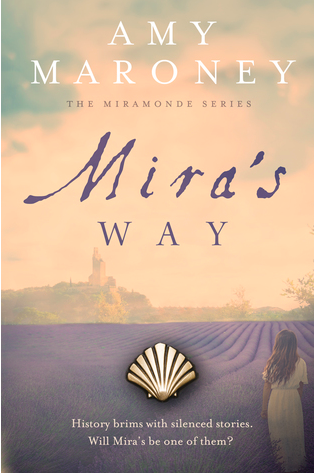
History brims with silenced stories—will Mira's be one of them?
Mira’s Way, Book 2 of The Miramonde Series, continues the mesmerizing tale of a Renaissance-era female artist and the modern-day art scholar who risks everything to learn her secret.
1504: Young artist Mira wants nothing more than a peaceful life by the sea, painting portraits of wealthy merchants. But when she and her new husband try to help a friend, they are catapulted into a series of dangerous adventures that leave them scrambling to survive.
2015: Art scholar Zari races through France, working feverishly to connect Mira with a series of masterful unsigned portraits. Meanwhile, an academic rival peddles his theory that the works were made by a famous male artist. Will Mira be lost to history forever?

“Only I know that my mark and my image is there. But there is always the chance that one day, someone else will find them…”
Sister Beátrice, the late Abbess of Belarac Abbey, had sworn to protect the daughter of Marguerite de Oto, Baroness of Oto, from her own father. For it was known that the House of Oto bears only sons. But, Mira was not destined to spend her life closeted behind walls. She is an artist — an incredibly talented one — and besides, she has fallen in love. Mira and her husband, Arnaud de Luz, plan to make a new life for themselves in Bayonne. When they reach Bayonne, life will begin. Arnauld would join a guild and produce the finest of furniture and Mira would paint the portraits of the wealthy merchants. However, fate has other plans for the newlyweds, and with a stroke of a brush, their lives take a decidedly different path to the one they had dreamed so often about.
They say that a picture is worth a thousand words, and if you look close enough, you might just discover the truth. However, sometimes, the harder you look, the less you see.
Lines, shape, colour, texture, symbolism — each painting tells a story, not only of the noblemen who are immortalised for all eternity due to the careful caress of a brush but also of the artist who painted it. There were only a few recognised female Renaissance artists. Art historian, Zari Durrell, knows that she is a but a breath away from discovering the truth about Miramonde de Oto and her paintings. However, like those brave women who dared to create even though they were widely overlooked and ridiculed, Zari must not be thwarted in her attempts by her fellow scholars who are determined to disprove and scorn her findings. Zari is unwavering in her determination to give Mira the recognition that she deserves.
Mira's Way (The Miramonde Series, #2) by Amy Maroney is the absorbing, wonderous, at times utterly heartbreaking, story of Miramonde de Oto and the woman who is determined to discover the truth.
Maroney has presented her readers with a book that is not only meticulously researched and exquisitely hewn, but also one that is compulsively readable and next to impossible to put down. I fell in love with the world and the characters which Maroney penned in The Girl from Oto (The Miramonde Series Book 1) and I was, with much anticipation, looking forward to reading book 2 in the series. Maroney’s breath-taking narrative effortlessly swept me back into the story, and I have to admit I hopelessly lost myself within the pages of this wondrous and emotionally charged story.
Like with the first book, Maroney has managed to evoke every human emotion between the two storylines that run throughout the course of this book. Sometimes with books that are set in two different periods, I find I become invested in only one of the periods and read the other with a lacklustre indifference. That was not the case with this book. I was just as committed to Zari’s story as I was to Mira’s. There is a beautiful balance in this book. Maroney has an intuitive understanding about when to switch timeframes, and the fact that Zari’s discoveries mirror Mira’s life makes this book really rather wonderful. A true gem.
It would be remiss of me not to commend Maroney for her attention to historical detailing and her knowledge of Renaissance art. The writing is seemingly effortless, I can only imagine that the research that went into this novel was not. Kudos, Ms Maroney.
I must mention Maroney’s portrayal of the Cagots. Their depiction was profoundly moving, and the fact that no one seemed to know why they were hated so much demonstrates how irrationally and how senseless prejudice is. Mira’s compassion for the Cagots made her a very compelling protagonists and one that was very easy to become emotionally invested in.
I don’t think words can adequately profess how marvellous this book was. I thoroughly enjoyed every minute of it, and I certainly did not want it to end. I look forward to reading Book 3 in this not-to-be-missed series.
I Highly Recommend.
Review by Mary Anne Yarde.The Coffee Pot Book Club.
Pick up your copy ofMira's Way(The Miramonde Series, #2)Amazon UK • Amazon US
Amy Maroney
 Amy Maroney lives in the Pacific Northwest with her family. She studied English literature at Boston University and public policy at Portland State University, and spent many years as a writer and editor of nonfiction before turning her hand to historical fiction. She’s currently obsessed with pursuing forgotten women artists through the shadows of history. When she’s not diving down research rabbit holes, she enjoys hiking, drawing, dancing, traveling, and reading. She’s the author of The Girl from Oto and Mira’s Way, the first two books in the Miramonde Series. The third book in the series will be published later in 2019. To receive a free prequel novella to the series, join Amy’s readers’ group at www.amymaroney.com. You can find her on Twitter @wilaroney, on Instagram @amymaroneywrites, and on Facebook.
Amy Maroney lives in the Pacific Northwest with her family. She studied English literature at Boston University and public policy at Portland State University, and spent many years as a writer and editor of nonfiction before turning her hand to historical fiction. She’s currently obsessed with pursuing forgotten women artists through the shadows of history. When she’s not diving down research rabbit holes, she enjoys hiking, drawing, dancing, traveling, and reading. She’s the author of The Girl from Oto and Mira’s Way, the first two books in the Miramonde Series. The third book in the series will be published later in 2019. To receive a free prequel novella to the series, join Amy’s readers’ group at www.amymaroney.com. You can find her on Twitter @wilaroney, on Instagram @amymaroneywrites, and on Facebook.
Published on June 07, 2019 20:30
#BookReview — The Briton and the Dane: Birthright (The Briton and the Dane Book #2) by Mary Ann Bernal

The Briton and the Dane: Birthright(The Briton and the Dane Book #2)By Mary Ann Bernal
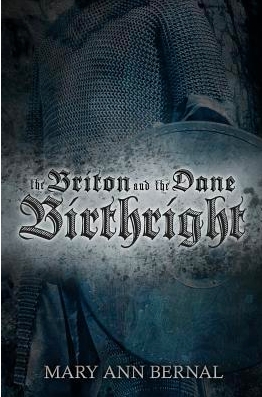
Travel back in time to 9th Century Anglo-Saxon Britain and the reign of Alfred the Great who successfully repelled the Viking threat and drove the formidable Danish King Guthrum out of his Kingdom of Wessex. Journey throughout Britannia where Lord Richard and his children risk their lives in the service of their King; where treachery and treason threaten the uneasy peace; where the outcome of one battle determines the course of history.

“Treason is punishable by death, no matter the bloodline...”
It has been two years since Alfred, King of Wessex, accepted the surrender of Guthrum, the leader of the Great Heathen Army. Due to Alfred’s terms, Guthrum has turned his back on his pagan ways and embraced the Christian God. By doing so, he now rules the land from Kent to Northumbria. It is enough. No longer does he hunger for the desire for more land and the blood of the battlefield.
However, there are those who see Guthrum’s surrender to the Christian faith as a weakness, and there is one among them which threatens the tranquil peace that Alfred and Guthrum have worked so hard to embrace.
Rigr, Guthrum’s illegitimate son, seeks the throne of his father. However, because of his illegitimacy, Guthrum refuses to recognise him as his heir. Driven by the desire for power, Rigr plots to overthrow his father and to his delight, he discovers that many would not only support his claim but fight alongside him. His course is set. He will win the Daneland from his father, no matter what the cost...
Set in a world of superstition, blood feuds, and revenge, The Briton and the Dane: Birthright (The Briton and the Dane Book #2) by Mary Ann Bernal is the utterly captivating fictional story, set in the time of King Alfred of Wessex and Guthrum of East Anglia.
I have already read several books in The Briton and the Dane series and I was very much looking forward to reading Birthright. I had high expectations for this book, and I am pleased to say that Bernal did not disappoint. Bernal has presented a story that is not only rich in historical detailing but one with an almost tangible realism.
From the opening sentence, I was hooked. The short chapters and quickly changing scenes worked surprisingly well. There is also a huge cast of characters which drove this book forward. Putting all of these things together made this novel unputdownable. In fact, I was so engrossed in this story that I read it in one sitting!
The period of history Bernal chose to base this book on is one where minimal primary sources have survived and although there are many works by Historical Fiction authors about Alfred the Great and his war with Guthrum, the period straight after is one which is sorely neglected by authors, and because of this Bernal's story is wonderfully original.
There are many characters in this book that a reader will love to hate — Rigr being one of them. His anger at his father is like an uncontrollable burning fire inside of him. He is ambitious, and it seems that nothing can thwart him in his quest to become King.
This book is not just about those who desire power. Like with Book #1, I was particularly taken with the character of Elizabeth, who despite being contradicted continuously, is convinced that her husband, who has been missing for two years, is still very much alive. I thoroughly enjoyed Elizabeth’s story.
From the onslaught, this book is filled with non stop drama and cliff-hanger tension. Bernal writes with a vivid imagination and an energy that threatens to memorise. She has a novelist eye for human frailty, and her characters are authentic in the telling.
Tense, powerful and utterly compulsive. I thoroughly enjoyed the second book in this fabulous series.
I Highly Recommend.
Review by Mary Anne Yarde.The Coffee Pot Book Club.
Pick up your copy ofThe Briton and the Dane: BirthrightAmazon UK • Amazon US
Mary Ann Bernal
 Mary Ann Bernal attended Mercy College, Dobbs Ferry, NY, where she received a degree in Business Administration. Her literary aspirations were ultimately realized when the first book of The Briton and the Dane novels was published in 2009. In addition to writing historical fiction, Mary Ann has also authored a collection of contemporary short stories in the Scribbler Tales series. Her latest endeavor is a science fiction/fantasy novel entitled Planetary Wars Rise of an Empire. Originally hailing from New York, Mary Ann now resides in Elkhorn, Nebraska.
Mary Ann Bernal attended Mercy College, Dobbs Ferry, NY, where she received a degree in Business Administration. Her literary aspirations were ultimately realized when the first book of The Briton and the Dane novels was published in 2009. In addition to writing historical fiction, Mary Ann has also authored a collection of contemporary short stories in the Scribbler Tales series. Her latest endeavor is a science fiction/fantasy novel entitled Planetary Wars Rise of an Empire. Originally hailing from New York, Mary Ann now resides in Elkhorn, Nebraska.Connect with Mary Ann: Website • Whispering Legends Press • Twitter.
Published on June 07, 2019 19:30
June 6, 2019
Check out Cathy Gohlke's fabulous new book — The Medallion #HistoricalFiction #WW2 @hfvbt
Historical Fiction Virtual Blog Tours Presents…
The MedallionBy Cathy Gohlke

For fans of bestselling World War II fiction like Sarah’s Key and The Nightingale comes an illuminating tale of courage, sacrifice, and survival, about two couples whose lives are ravaged by Hitler’s mad war yet eventually redeemed through the fate of one little girl.
Seemingly overnight, the German blitzkrieg of Warsaw in 1939 turns its streets to a war zone and shatters the life of each citizen–Polish, Jewish, or otherwise. Sophie Kumiega, a British bride working in the city’s library, awaits news of her husband, Janek, recently deployed with the Polish Air Force. Though Sophie is determined that she and the baby in her womb will stay safe, the days ahead will draw her into the plight of those around her, compelling her to help, whatever the danger.Rosa and Itzhak Dunovich never imagined they would welcome their longed-for first child in the Jewish ghetto, or that they would let anything tear their family apart. But as daily atrocities intensify, Rosa soon faces a terrifying reality: to save their daughter’s life, she must send her into hiding. Her only hope of finding her after the war–if any of them survive–is a medallion she cuts in half and places around her neck.Inspired by true events of Poland’s darkest days and brightest heroes, The Medallion paints a stunning portrait of war and its aftermath, daring us to believe that when all seems lost, God can make a way forward.
Excerpt
Read and excerpt from The Medallion HERE!
Giveaway
During the Blog Tour, we will be giving away 5 paperback copies of The Medallion! You can enter, HERE!Giveaway Rules• Giveaway ends at 11:59 pm EST on June 19th. You must be 18 or older to enter.
• Giveaway is open to US only.• Only one entry per household.• All giveaway entrants agree to be honest and not cheat the systems; any suspicion of fraud is decided upon by blog/site owner and the sponsor, and entrants may be disqualified at our discretion.• The winner has 48 hours to claim prize or a new winner is chosen.
Pick up your copy ofThe MedallionAMAZON • BARNES AND NOBLE • BOOKS-A-MILLION • CBD.COM • WAL-MART.
Cathy Gohlke
 Cathy Gohlke is the three-time Christy Award-winning author of the critically acclaimed novels The Medallion, Until We Find Home, Secrets She Kept (winner of the 2016 Carol and INSPY Awards), Saving Amelie (winner of the 2015 INSPY Award), Band of Sisters, Promise Me This (listed by Library Journal as one of the best books of 2012), William Henry Is a Fine Name, and I Have Seen Him in the Watchfires (listed by Library Journal as one of the best books of 2008), which also won the American Christian Fiction Writers’ Book of the Year Award.Cathy writes novels steeped with inspirational lessons from history. Her stories reveal how people break the chains that bind them and triumph over adversity through faith.
Cathy Gohlke is the three-time Christy Award-winning author of the critically acclaimed novels The Medallion, Until We Find Home, Secrets She Kept (winner of the 2016 Carol and INSPY Awards), Saving Amelie (winner of the 2015 INSPY Award), Band of Sisters, Promise Me This (listed by Library Journal as one of the best books of 2012), William Henry Is a Fine Name, and I Have Seen Him in the Watchfires (listed by Library Journal as one of the best books of 2008), which also won the American Christian Fiction Writers’ Book of the Year Award.Cathy writes novels steeped with inspirational lessons from history. Her stories reveal how people break the chains that bind them and triumph over adversity through faith.When not traveling to historic sites for research, she, her husband, and their dog, Reilly, divide their time between Northern Virginia and the Jersey Shore, enjoying time with their grown children and grandchildren.Connect with Cathy: Website • Facebook.

Published on June 06, 2019 21:00
June 5, 2019
#HistoricalRomance author, Penny Hampson, is taking a look at the diaries of Samuel Pepys #History @penny_hampson
An Author’s Inspiration:The Diary of Samuel Pepys By Penny Hampson
If you asked me what inspired and continues to inspire me to write, I would have to say it is my fascination for discovering the lives of people from the past. Strangely, I was never any good at history at school — although I was passionate about learning about the past, I never seemed to achieve the standard required by my teacher (a scary woman) and eventually, when forced to make a choice between subjects, I gave it up. But that didn’t end my love affair with all things historical. I continued to devour books on historical subjects in my own time.
Some years later, at home with two young children, the prospect of returning to work as a civil servant did not appeal. I decided to return to the formal study of history and enrolled with the Open University. Studying part-time in this way meant I could fit my studies in with family life. The rest, as they say, is history. Studying with the OU was certainly one of the better decisions of my life (apart from marrying my lovely husband of course, who supported and encouraged me all the way).
For many people, history usually means looking at the broad strokes — political movements, government decisions, wars, cultural aspects, which is always interesting (honestly), but I’m interested in the details too — the clothes, the pastimes, the food, and especially the personalities.
I’ve studied and read about all the obvious ones, like the Tudor and Stuart monarchs, and the figures who peopled their courts. I’ve also discovered others who, though important, were not royalty, but movers and shakers in other spheres.
One such personality is my very first history ‘crush’ — the Restoration diarist Samuel Pepys (1632-1703). His lively and evocative diary (now available online at Project Gutenberg and also at The Diary of Samuel Pepys is one of the most enthralling documents that I have ever read. His character comes across so vividly — the meticulous, thorough, archetypal civil servant, who adores theatre-going, is passionate about music, who occasionally is mean and petty (especially to his poor wife, Elizabeth)… and, it has to be said, is a bit of a lad (to put it mildly). Pepys tried to hide his innermost naughty thoughts by putting them in a mix of different languages, even though the diary itself is entirely written in shorthand anyway, inaccessible to most people, and certainly to his wife.
 Pepys by John Riley, courtesy of Yale University Art Gallery.
Pepys by John Riley, courtesy of Yale University Art Gallery.Pepys was witness to some of the most significant events of the age. Because of his cousin, patron, and generous benefactor, Sir Edward Mountagu, Earl of Sandwich (1625-1672), Pepys was present in May 1660 when Charles II arrived back in England to reclaim the throne. Shortly after, again, with Mountagu’s patronage, Pepys became one of the Principal Officers of the Navy, being made Clerk of the Acts to the Navy Board, and so found himself well placed to observe all the goings-on of court life. All these events and more Pepys meticulously records in his diary, which he kept from January 1660 until 31st May 1669.
 Edward Mountagu, 1st Earl of Sandwich, by Peter Lely.
Edward Mountagu, 1st Earl of Sandwich, by Peter Lely.Through his diary I experienced his fear of the Plague that raged through the country in the summer of 1666 and felt his dread at the Great Fire of London in September the same year.
‘I…walked, through the City, the streets full of nothing but people and horses and carts loaden with goods, ready to run over one another, and, removing goods from one burned house to another.’
There is excitement of another sort when on 21st May 1662 Pepys notes:
‘And in the Privy-garden saw the finest smocks and linnen petticoats of my Lady Castlemaine’s, laced with rich lace at the bottom, that ever I saw; and did me good to look upon them.’
Pepys was a noted admirer of ladies, some might say he used his position of power to enjoy rather intimate liaisons with the wives and daughters of navy personnel under his command, and there were numerous escapades with ladies of easy virtue he happened to meet during the course of the day. On 18th August 1667, he records that he tried to grope a lady in church, who was to his disappointment, not so willing: ‘at last, I could perceive her to take pins out of her pocket to prick me if I should touch her again — which seeing I did forbear.’ It doesn’t however stop him moving on to another young lady who is a little more permissive — all that during one church service, then going off to join his long-suffering wife!
 Image of Elizabeth Pepys, an engraving of 1825 by James Thomson after John Hayls.
Image of Elizabeth Pepys, an engraving of 1825 by James Thomson after John Hayls.Pepys enjoyed all the finer things in life, such as visits to the theatre, dining with friends, and musical evenings. One of the most moving diary entries for me occurs on 27th February 1667/8
‘But that which did please me beyond any thing in, the whole world… which is so sweet that it ravished me, and indeed, in a word, did wrap up my soul so that it made me really sick, just as I have formerly been when in love with my wife; that neither then, nor all the evening going home, and at home, I was able to think of any thing, but remained all night transported, so as I could not believe that ever any musick hath that real command over the soul of a man as this did upon me.’
Pepys perfectly captures that feeling of pleasure one gets when hearing a particularly fine piece of music, even comparing it to the ecstasy of falling in love. For all his sins, and he had a few, Pepys certainly had soul.
Despite all his faults, I’m a big fan of Pepys, mainly I think, because he is so human. He makes vows to be good, which he adheres to, sometimes for quite lengthy periods, and then he breaks them. Who cannot identify with that human frailty?
One of the highlights of my life was reading some of Pepys’ original papers, which are held in the Rawlinson Collection at the Bodleian Library in Oxford; I have yet to visit the Pepys Library at Magdalene College, Cambridge, where his original diaries, books, manuscripts, documents and prints are held. It is on my list!
So, it was discovering Pepys, and others like him, that fired my enthusiasm for history. Why not read a little of Pepys’ diary and transport yourself to Restoration England - you’ll be amused, probably shocked, but also come to understand that essentially, human emotions and concerns remain pretty constant through the ages.
References:Image of Pepys by John Riley, courtesy of Yale University Art Gallery.Image of Elizabeth Pepys, an engraving of 1825 by James Thomson after John Hayls.Image of Edward Mountagu, 1st Earl of Sandwich, by Peter Lely, courtesy of Yale Centre for British Art.
An Officer’s VowBy Penny Hampson
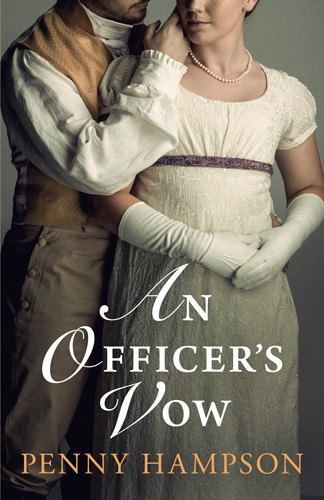
The future looks bleak to Major Nate Crawford. Depressed after being sent home from the Peninsular Campaign as unfit for service, he contemplates ending it all. Then an unexpected opportunity for adventure beckons in the shape of a delightfully intriguing runaway heiress. He will prove his worth as an officer and a gentleman by offering his help. He has a plan…
Lottie Benham is desperate. Her life is in danger and she needs a place of safety until her next birthday. The unexpected proposal from this attractive, but intimidating officer could be the answer to her prayers. Not normally a risk-taker, she decides to gamble all by placing her trust in this charismatic gentleman, who she suspects might be more in need of help than she.But the best laid plans…
Caught up in conflict, danger, and deception, will Lottie and Nate survive to find the perfect solution to their problems?
Amazon UK • Amazon US
Penny Hampson
 Having worked in various sectors before becoming a full time mum, Penny Hampson decided to follow her passion for history by studying with the Open University. She graduated with honours and went on to complete a post-graduate degree.
Having worked in various sectors before becoming a full time mum, Penny Hampson decided to follow her passion for history by studying with the Open University. She graduated with honours and went on to complete a post-graduate degree. Penny then landed her dream role, working in an environment where she was surrounded by rare books and historical manuscripts. Flash forward nineteen years, and the opportunity came along to indulge her other main passion – writing historical fiction. Encouraged by friends and family, three years later Penny published her debut novel A Gentleman’s Promise.
Penny lives with her family in Oxfordshire, and when she is not writing, she enjoys reading, walking, swimming, and the odd gin and tonic (not all at the same time).Connect with Penny: Website • Twitter
Published on June 05, 2019 23:00
June 4, 2019
Join Anna Belfrage as she talks about the myth that sparked the inspiration for her wonderful series — The Wanderer #AncientGreekMyths #Inspiration #mustread @abelfrageauthor #GreekMyth #amwriting #
A myth that sparked a storyAn Author’s InspirationBy Anna Belfrage
First of all, thank you Mary Anne for the invite to visit your marvellous blog—again. Today, I thought I’d share with you the myth that sparked the inspiration that resulted in my series The Wanderer, the story of two people who lived, lost and died 3 000 years ago. Now Jason and Helle are back, but will they make it to a Happily Ever After this time round?

”So why Jason?” Helle settled herself closer to him and extended her legs towards the crackling fire in the hearth.
“Hmm?”
“Why did she name you Jason? Your first mother?”
“Ah.” He slid her a sidelong glance, his mouth twitching slightly. “It no longer scares you sideways to accept that I have had many, many mothers?
”Oh, it does.” More to the point, it scared the daylights out of her to realise that she too had also had a long, long line of mothers prior to the one she had in this life—none of whom she remembered, thank God.
“It’s a bit like asking why your long-dead first father named you Helle, isn’t it?”
“Nope.” Helle had but the vaguest memories of this ancient man, a blurry image of a large man with a head of fair curls and a beard to match. “It made sense for him to name me Helle.” She grinned. “I am, after all, a descendant of Helios himself.”
Jason snorted. “So you believe all that stuff about Aries, the Golden Ram, and the two children he saved?”
“Phrixus and Helle.” She smiled. “I’m not sure I believe it, but at least it explains why I was named Helle—after the little girl who rode with her brother on the Golden Ram but fell off when she heard the mermaids singing—hence the Hellespont.”
“Hmm, yes. And so Phrixus arrived in Kolchis without a sister but with a golden ram who quickly became a golden fleece, the most prized possession of the king of Kolchis.” Jason leaned forward to add some more wood to the fire. “It’s dangerous to have prized possessions. Makes all sorts come looking for them.”
“Yeah. And in this particular case, the one who came looking was Jason—and the Argonauts.” She ran her hand through Jason’s thick, mahogany coloured hair. “I wonder if he looked like you.”
“I hope not,” Jason muttered. “That namesake of mine was not only a thief, but also a breaker of vows.”
“Ah, yes.” She snuggled into his arms. “Tell me,” she said.
He laughed softly and hugged her close. “Like a bedtime story?”
“Yes. I love it when you tell me stories.”

He sat silent for a while. “This was all very long ago, in the times when Troy still stood and heroes like Heracles walked the earth. In fact, Heracles was one of the Argonauts, having joined Jason and several other famous Greek heroes aboard the mythical ship Argo. As to Jason, let’s just say he had a tough childhood, but at least he had Hera, the goddess, on his side.”
“He was raised by a centaur, wasn’t he?” Helle said.
“He was. Poor little baby, hidden away so that his uncle wouldn’t murder him. Once Jason grew up, he set off on a quest to find his destiny. Ironically, it was Jason’s uncle, Pelias, who lumbered Jason with the task of stealing the Golden Fleece and bringing it back to Greece. Pelias probably hoped Jason would die during the course of the journey, sparing him the effort to murder him. After all, the throne Pelias occupied rightfully belonged to Jason’s father. But where Pelias never saw Jason’s weak father as a threat, he quickly realised Jason was far more dangerous.
As we all know, Jason didn’t die. Instead, after numerous adventures, he and his companions arrived in Kolchis where they were met with polite distrust by King Aeetes. The man was no fool, and all these handsome Greek heroes probably made him very nervous, but the kings of Kolchis were not only kings, they were also powerful wizards, so the Golden Fleece was protected by a dangerous dragon and thereby impossible to steal. Unless, of course, one had help from someone as magically skilled as the king of Kolchis.”
Helle sat up. “This would be like Sam’s ancestor, wouldn’t it?” She grimaced. Samion, wizard prince of Kolchis was no favourite of hers, neither in his first reincarnation or in this his latest, as powerful financial mogul Sam Woolf.
“Yes. And yours.”
“Eeuuuw!!!” She shook herself. Just the thought that she shared some DNA—however little—with Sam had her breaking out in hives.

“Going back to our story,” Jason said, “King Aeetes decided to have some fun with his somewhat unwelcome guests. He promised Jason the fleece if he would perform three tasks for him: he was to yoke the fire-breathing Khalkotauri oxen to the plough and plough a field, he was to sow the field with the teeth of a dragon and take care of the resulting crop and then, as a final test, he was to bypass the guardian dragon. If he survived all these three tests, Aeetes would happily give him the Golden Fleece. Thing was, no mortal man could approach those oxen without being burned to a crisp, and as to those dragon teeth, who knew what crop would spring from them?
Jason quickly concluded that the only way to survive these tests was to convince the king’s daughter, Medea, to help him. Medea was beautiful and I don’t think our hero found it that much of a hardship to woo her. And she, well she had never met a man as handsome as Jason, a man whose mere presence had her heart racing—this very much with the help of Aphrodite and Eros, whom the goddess Hera had roped in to help her protect her precious Jason.”
“So he never fell in love with her?” Helle asked, while in her mind a shadowy figure of a young woman with dark, dark hair and arresting eyes took shape.
“I don’t think so.” Jason sounded sad. “A means to an end, that’s what she was. Anyway; the besotted Medea helped Jason overcome the three challenges on condition that he would marry her and take her with him when he left. This Jason promised to do, and soon enough Jason had the Golden Fleece in one hand, Medea in the other, and was running for his life with an enraged Aeetes in pursuit. The king claimed trickery and treachery—his own daughter had helped this Greek upstart steal their most precious family heirloom.
Jason and Medea made it to the Argo. The Argonauts threw themselves on their oars to attempt to outrun the ships from Kolchis, but Aeetes was gaining on them—until Medea compounded her sins by killing her brother and throwing his dismembered corpse in the sea. Aeetes howled in grief and rage, ordering his ships to stop and salvage the bits and pieces of his son that were bobbing in the water.”
“Poor Medea. So in love with a man she not only betrayed her house but also committed fratricide,” Helle said. “I wonder what Jason thought of that.”

“He seems to have been a man with a Machiavellian approach to things,” Jason said drily. “You know, the ends justify the means. In this case, a dead boy ensured the Golden Fleece could be delivered to Greece, with Jason returning as a conquering hero—and with the enigmatic sorceress Medea by his side. Quite the power-duo, those two, and for several years they rubbed along quite happily, with various little incidents along the way.” Jason shook his head. “Medea was one rather blood-thirsty woman, as demonstrated by the time she tricked King Pelias’ daughters to kill their own father, promising them that once the old man had been slaughtered and placed in the pot, a young, vital man would leap forth—just as it did when Medea gave them a demonstration with a ram. Except, of course, that when the poor girls tried to reanimate the various body parts of their dead papa, nothing happened.”
“Ugh!” Helle said.
“Ugh indeed. Medea would say she was merely exacting revenge on behalf of her husband, whose throne King Pelias has usurped.” He stroked her head. “She did love him, I think. She loved Jason to distraction, gave him a dozen children or so, and then, just like that, he falls in love with Glauce, the pretty daughter of the king of Corinth. Medea was devastated. And angry. So she sent Glauce a poisoned dress and coronet, thereby murdering Jason’s beloved. She then fled for her life, with an enraged Jason in pursuit.”
“Wait, wait. What about her kids? She killed them, didn’t she?”
Jason smiled. “Not in the versions I first heard.”
She rolled her eyes. Just because he remembered every single one of his fifty-odd lives…
“In Euripides’ play, Medea murders two of her sons,” Jason continued. “Prior to that version, there was no mention of any baby killing, just a woman harnessing sun-dragons to her chariot and fleeing due east, returning at last to Kolchis.”
“So what happened to all her kids?”
“No idea. I guess they stayed with their father. That’s the way it was until relatively recently: children belonged with their father, not with their mother.”
“And Jason?”
“Ah, Jason. Well, Hera was most displeased with him for having betrayed his vows to Medea. Without Hera’s protection, life unravelled for Jason and he was to spend his remaining years very much alone. One night, as he was sleeping under the shadow of the rotting Argo, he was crushed to death by a part of its keel. The ship that carried him on his greatest adventures thereby also became the cause of his death—a rather elegant element of poetic justice.”
Jason looked down his nose at her. “And the reason why my long-gone mother named me Jason was because she was sick and tired of hearing your father go on and on about how you were all descended from the sun god himself. My name was supposed to serve as a reminder that sometimes the most precious things we have can be stolen away from those we least expect to do so.”
Helle cupped his cheek. “Like you stole my heart away.”
“Wrong way round, Helle. You stole mine the first time I saw you.” He brushed a long digit down her cheek. “And then you stole my soul forever in a glade that shimmered in dappled sunlight, with the wind whispering love songs in the poplars overhead.”
“Huh,” Helle said, clearing her throat of a wad of emotion. “I guess there’s some sort of divine justice in the fact that Medea and Jason never made it to the happily ever after.” She pressed herself closer, her ear to his chest. “Will we, do you think?”
“I don’t know, my lioness.” His arms tightened round her. “But I will do everything I can to make it happen. Seems to me we bloody deserve a happy ending after all these long, long fruitless years.”
Yes, Helle though. They sure did. But deserving didn’t mean getting… She gulped down a wave of fear. Tonight, things were okay in her world. Tonight, she lay safe in her Jason’s arms. She’d worry about that damned vindictive bastard Sam Woolf tomorrow. Yes, tomorrow.
A Torch In His Heart (The Wanderer Book 1)

In the long lost ancient past, two men fought over the girl with eyes like the Bosporus under a summer sky. It ended badly. She died. They died.
Since then, they have all tumbled through time, reborn over and over again. Now they are all here, in the same place, the same time and what began so long ago must finally come to an end.
Ask Helle Madsen what she thinks about reincarnation and she’ll laugh in your face. Besides, Helle has other stuff to handle, what with her new, exciting job in London and her drop-dead but seriously sinister boss, Sam Woolf. And then one day Jason Morris walks into her life and despite never having clapped eyes on him before, she recognises him immediately. Very weird. Even more weird is the fact that Sam and Jason clearly hate each other’s guts. Helle’s life is about to become extremely complicated and far too exciting.
Amazon UK • Amazon US
Smoke In Her Eyes
(The Wanderer Book 2)
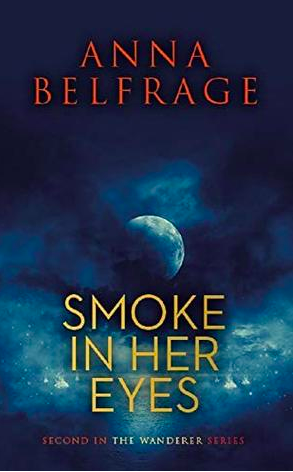
Six months ago, Helle Madsen would have described herself as normal. Now she no longer knows if that terms applies, not after her entire life has been turned upside down by the reappearance of not one, but two, men from her very, very distant past.
Helle Madsen never believed in mumbo-jumbo stuff like reincarnation—until she came face to face with Jason Morris, a man who purportedly had spent fifty lives looking for her. Coping with being reunited with the lover from her ancient past was one thing. Having Sam Woolf, her vindictive nemesis from that same ancient past join the party was a bit too much. Suddenly, Helle finds herself the reluctant heroine of a far-flung, time-transcending epic story, one in which pain and loss seem to play a very big part.
This time round, Jason and Helle are determined to make it to the happily ever after. Unfortunately, Sam Woolf will stop at nothing to crush them. That ride into the golden sunset seems awfully far away at times…Amazon UK • Amazon US
Anna Belfrage

Find out more about Anna and her books on her website or on her Amazon page. Follow her on FB or Twitter. And as to Jason and Helle, the first book in the series is A Torch in His Heart, the second, Smoke in Her Eyes, was released in March 2019.
Published on June 04, 2019 22:00
June 3, 2019
Check out the cover of John Drake’s upcoming book — The Traitor of Treasure Island #CoverReveal #Historical @JohnDrakeauthor @EndeavourQuill
The Traitor of Treasure IslandBy John Drake
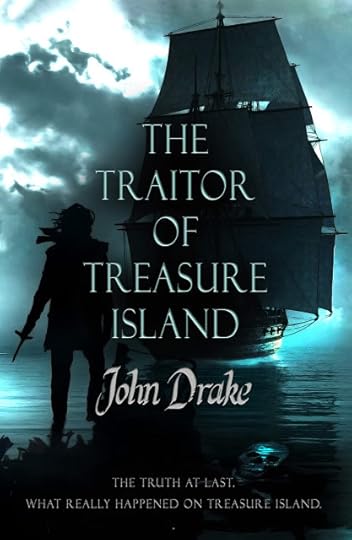
Buried for over 300 years and now brought triumphantly to light by Dr Livesay, this is, at last, the true story of what happened on the fateful Treasure Island…
The truth about Captain Flint and his fabled death.
The truth about Long John Silver and his coveted wife.
And the truth about Jim Hawkins, that double-dealing turncoat of the first order: The traitor of Treasure Island.
Excerpt
‘Stand by, Mr Bones!’ I said.
‘Aye-aye!’ he replied, and faced the shivering door with a pistol in one hand and a cutlass in the other, as I gave Mrs Charlotte a pistol and tried to give one to Jim Hawkins. But he just shook his head, even when one of the little serving girls spoke.
‘I’ll take it, Doctor,’ she said.
‘Good girl!’ I said, and looked to Mrs Charlotte. ‘I’m off upstairs,’ I said, ‘to see what I can do.’
‘Be careful, Doctor,’ she said, ‘be careful, my dear man.’ And this time I had no strength left to resist, so I kissed her on the lips not caring who might see.
‘David!’ she said.
‘Charlotte!’ I said, and I was hers and she was mine for ever… provided only that we survived the night.
So up the stairs at the run, fumbling in the dark for the front bedroom, and there lay Jamie Woolacombe in his brother’s arms, shot twice and ugly through the head, and gone beyond aid. But I had brought the blunderbuss and a pistol, and, keeping my head well down, I crept to the window and fired one of Monsieur Brudatour’s weapons at the stars. This produced the expected volley from the enemy outside, after which I stood up and gave fire from the blunderbuss with a dozen pistol balls over four drachms of black powder. I aimed where I guessed our enemies stood; the weapon thundered and kicked, the flash lit the night, scraps of wadding smouldered and fell, and men groaned and shrieked.
So they paid dear for Jamie Woolacombe.
But again, the strong, clear voice sounded, and as I ran downstairs again I heard the front door being smashed in, and men roaring and bellowing and firing pistols into the woodwork to break the door still further, which indeed they were doing, as nails yielded and timber groaned, while vigorous arms could be seen through the gaping planks, swinging hammers in the moonlight.
‘Charlotte!’ I cried, ‘Get into the tap-room with the girls!’‘Take care, David!’ she said, and she fell back, as did the boy Jim: miserable wretch that he was, he took no part in the fight.‘Stand by, Mr Bones!’ I said.
‘Aye-aye!’ he said. Then, since I had not asked before:
‘Who are they, Mr Bones? What do they want?’
‘It’s him,’ he said. ‘Out of his grave. And he’s after what I’ve got.’‘Who is?’
‘Flint,’ he said, and no more words were possible, as the door fell down in shards and wreckage, and Billy Bones and I fired our pistols, and a fusillade came from outside, and Billy Bones was stumbling, and men were falling, and there came a great rushing of bodies over the ruined planks, and Billy Bones roared like a lion and laid on left and right with his cutlass, and I struck out with the fireside poker for want of anything better.
So it was Hell and Bedlam, and while I did my best, it was only the huge and furious Billy Bones that saved us. It was him, together with three shots fired, close-range at our enemies, in the wavering moment when either side might have prevailed: a charge of goose-shot from Ernest Woolacombe, come downstairs with his gun, and two rounds from Charlotte who would not cower in safety, but stood forth with the pistols I’d given her and the serving girl.
Then the enemy screamed and fled, and Billy Bones was out into the night, swinging one final and enormous blow that would have cleaved his victim from scalp to collar-bone, except that the cutlass thumped into the swinging sign of the Admiral Benbow, leaving a notch that survives — with great fame and reputation — even to this very day.
Coming soon...
AddThe Traitor of Treasure Islandto your “Want to read” list onGoodreads
John Drake
 John Drake trained as a biochemist to post-doctorate research level before realizing he was no good at science. His working career was in the television department of ICI until 1999 when he became a full-time writer. John's hobby is muzzle-loading shooting, and his interests are British history and British politics (as a spectator), plus newspapers, TV news, and current affairs. He is married with a son and two grandchildren.
John Drake trained as a biochemist to post-doctorate research level before realizing he was no good at science. His working career was in the television department of ICI until 1999 when he became a full-time writer. John's hobby is muzzle-loading shooting, and his interests are British history and British politics (as a spectator), plus newspapers, TV news, and current affairs. He is married with a son and two grandchildren.
Published on June 03, 2019 22:00
Join #HistoricalRomance author, Sarah Dahl, as she takes a look at the myths behind Viking warriors #Vikings #History @sarahdahl13
Myths, Legends & Folklore
A Viking warrior knows no fear – or does he?
By Sarah Dahl

Vikings had and have a reputation of being fearless warriors. Enemy troops reported that Vikings had the advantage of not being fazed by the carnage; and that they sought an honourable death above all, to gain a good reputation. We know their mindset and religion was focused on the idea to die honourably and go to Odin’s dining table (Valhalla) rather than saving their lives and being cowards. Which is what made them so feared and effective, even when they appeared in small numbers: Where other troops would hold on to their life and rather withdraw than be eliminated, the Viking warriors often or at least more willingly kept charging until death (and therefore the lovely Valkyries collected them).
So this is how the Vikings are depicted in fiction and history books: the myth of the fearless warrior. But in my research and writing I always want to look behind the hard, historical facts, and at the human behind the myth. Could these men really have been that fearless? Weren’t they just human?
In historical fiction I often can’t find the notion that the warriors lining up to battle were human, more than moving formations and blood-spilling servants.
No matter how well-trained they were and how fearless they seemed to appear – they surely knew the cold sweat and stuttering heart right before the enemy charged in. And that urge to just run.
Luckily, Hjardar/Vike in their brilliant “Vikings at War” describe the long period leading up to a battle as surely also leading to fried nerves. To strengthen morale, they performed rituals and listened to their chieftain’s address; and they pumped up egos with chants, duels, shouting of abuse, and other displays of strength. Once the lines were ready to clash, Hjardar/Vike describe, the men “would have been stricken with nervousness … mumble protective incantations and prayers, checked their weapons one last time, checked that their neighbours were as focused as they were.” The beating of shields and war cries heightened the tension to bursting point. They add, “Many nervous bowels were emptied in the few minutes before hell broke loose.” See that? A Viking warrior shitting himself? Now that is new.
I absolutely love this description - because it gives the cold, historical facts of what it meant to fight a battle a very understandable, human depth.
In my writing, I always try to be honest to human emotions. So in my Tales of Freya featuring the warrior couple Nyssa and Aldaith (“The Current”, “Bonds”, “Battles”), I show their brave warrior mindset AND the range of emotions. They are trained and focused, they know what they let themselves into and are prepared to die and go to Valhalla (not exactly a bad place to end up in). So this is what they put in the forefront of their minds, to counter fear and stay focused.
But once they fall for each other, once they are in love, they encounter an entirely new problem: Fear. While managing to push back the well-known fear of dying with the usual means of comradeship, routine preparations, chants, and fighting moves, something else keeps creeping in and distracting them: Fear - for the other.
They suddenly know what it means to panic. They suddenly are scared to lose the one they love most. They are distracted, making themselves vulnerable at the worst imaginable time. Aldaith is very much upset and confused by this new finding – that he fears for Nyssa’s life, not his own. They still don’t fear death as such, they are still exceptional fighters – but suddenly they are afraid to be left behind on this earth, to have to face life alone, to have to watch the lover die. Surely, Aldaith’s chieftain wouldn’t have liked his new confusion. It is exactly why chieftains preferred unmarried men as their soldiers, those who weren’t too attached and missed at home. Often they were away for years; families had to cope without them – and sometimes never learned if their sons or husbands lived or had died. Too much attachment can become a very humane problem.
In my Tales, I bring this issue TO the warriors. They have no attachments at home, but love finds them on the battlefield. My couple train and duel together, they fight, sleep, and love shoulder to shoulder. And this then becomes their weakness.
Before the carnage (in “Battles”), Aldaith has this feeling of foreboding. He’s nervous, looks out for Nyssa. He is distracted during the frenzy to an extent that almost gets him killed, and when he can’t see his lover anymore, he almost loses his mind, risking his life in a move that endangers his comrades. I totally see why his chieftain wouldn’t be happy about this: a distracting love affair in his ranks.
In “Bonds” and “Battles” I show the new, unforeseen dilemma of love: the warriors’ emotions get in their way, making them question what they knew and felt all their fighting lives. Aldaith and Nyssa might still be fearless and ready to die, but not for their lover to die and leave them behind. The pain that comes with that is unbearable.
So their last battle turns out to be the ultimate test – of their skills, focus, and bond. And in the end, they face an impossible decision. Not because of war, but because of the love they found.
Additional source: Vikings at War, Kim Hjardar/Vegard Vike
Tales of Freya A collection of sensual short stories set in the Viking Ageby Sarah Dahl
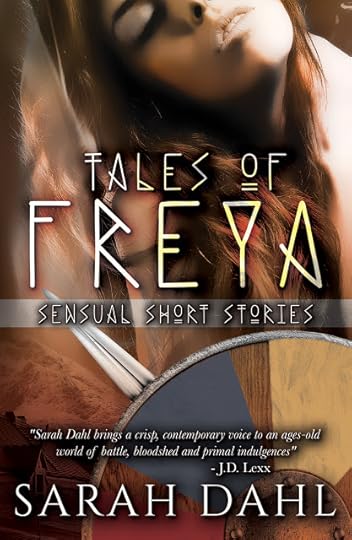
In a world of crackling fires and rough landscapes, long winters and bloody raids, the immediacy of life and death ignites undeniable passions. Warriors and monks, healers and housewives – all follow the call of their hearts and bodies to indulge in pleasures that may forever change their lives.
In this collection of adult bedtime stories, Sarah Dahl pulls back the curtain of history to depict the erotic lives of Viking men and women. Amid the stark landscapes of fjords, forests and snowcapped mountain peaks, her characters search for love and passion. Dahl authentically illuminates the sensual side of a world of battle and plunder in an alluring collection perfect for every lover of gritty Viking romance.
Pick up your copy ofTales of FreyaAmazon UK • Amazon US
Sarah Dahl
 Sarah Dahl lives on the edge of the rural German Eifel and writes historical fiction (novels and short stories) primarily set in the Viking age. She was an editor in several German publishing houses and managed a translation agency. The magic of writing re-entered her life at UCD Dublin, where she sat in J.R.R. Tolkien’s office every day, while working on the ‘Dictionary of Hiberno-English’. Tolkien’s spirit must have done something to her creative muscles – it sure wasn’t the bland view from his office. She became a full-time writer soon after and still works as an editor, translates, and coaches new authors. She is interested in everyday life in bygone centuries and the human stories that may have occurred behind the hard, historical facts.
Sarah Dahl lives on the edge of the rural German Eifel and writes historical fiction (novels and short stories) primarily set in the Viking age. She was an editor in several German publishing houses and managed a translation agency. The magic of writing re-entered her life at UCD Dublin, where she sat in J.R.R. Tolkien’s office every day, while working on the ‘Dictionary of Hiberno-English’. Tolkien’s spirit must have done something to her creative muscles – it sure wasn’t the bland view from his office. She became a full-time writer soon after and still works as an editor, translates, and coaches new authors. She is interested in everyday life in bygone centuries and the human stories that may have occurred behind the hard, historical facts.Connect with Sarah: Website • Newsletter• Facebook • Twitter • Instagram • Goodreads.
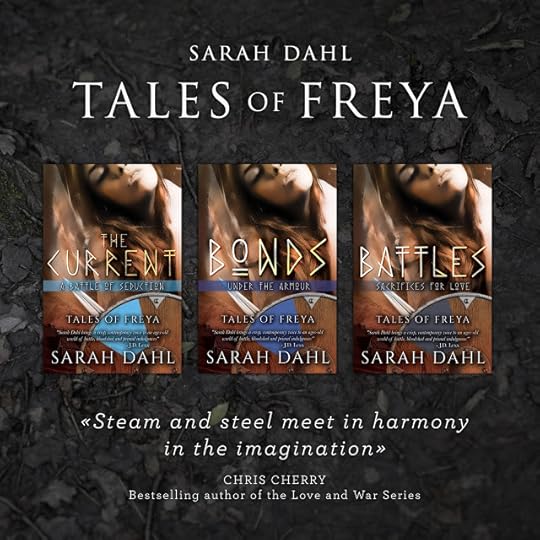
Published on June 03, 2019 21:00
Join Historical Fiction author, Samantha Wilcoxson, as she explores the inheritance of Queen Mary I #History #Tudors @carpe_librum
Inheritance of Queen Mary IBy Samantha Wilcoxson
What do we inherit from our parents? Physical features, personality traits, and possibly a nest egg of carefully gathered wealth? In rare cases, that inheritance includes a crown, and few monarchs were bequeathed quite the collection of mixed blessings as Queen Mary I.
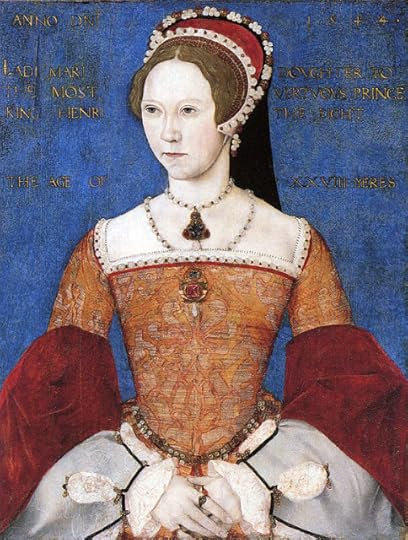 Mary in 1544.
Mary in 1544.From her father came England’s throne after its brief time with her younger brother, Edward. King Henry VIII had changed the course of history and turned his back on Catholicism to avoid having his daughter inherit the kingdom, but it was all for naught. In 1553, Mary became queen after enduring neglect, bastardization, persecution, and heartbreaking losses.
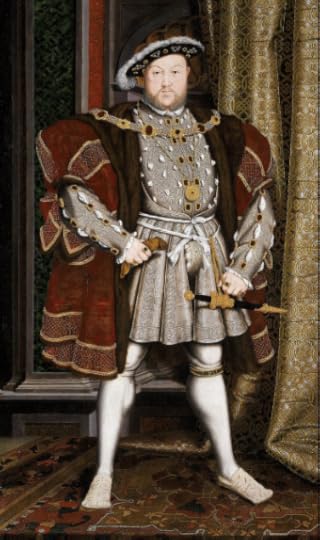 Portrait of Henry VIII by the workshop of Hans Holbein the Younger.
Portrait of Henry VIII by the workshop of Hans Holbein the Younger. What else had Mary inherited from Henry? Some believe that she inherited his fiery temper and willingness to send anyone who stood in his way to the execution block. It is easy to see how people come to this conclusion. Henry executed thousands of people, including one of his best friends, Thomas Moore, the devoted Thomas Cromwell, and two of his wives. When Mary came to the throne of a kingdom struggling with the Reformation, she restored Catholicism and had 286 Protestants burned at the stake. On the surface, one might think this act was revenge for everything she and her fellow Catholics had been put through.
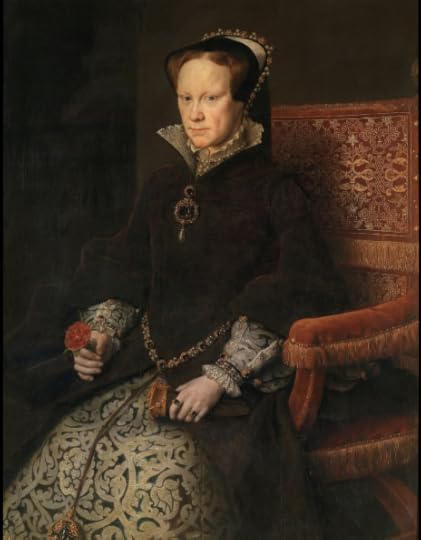 Queen Mary I, Portrait by Antonis Mor, 1554
Queen Mary I, Portrait by Antonis Mor, 1554A closer look shows us a different story. Throughout Europe, nations were searching for solutions to the divided church, and each side was persecuted in its turn. In Mary’s case, she believed it was her duty as “mother” of her country to see her children returned to the “true faith” and assured of their salvation. Ridding the land of those who would lead others astray was considered one of her responsibilities, and while burning was a horrible death people of the 16th century saw it as a final mercy, giving heretics one last opportunity to feel the flames of hell while they still had a chance to repent and spend an eternity in heaven.Whether we agree with Mary’s view of faith, we must admit that the reasons for the deaths during her reign are not the same selfish reasons of her father. On the contrary, much of her boldness of faith was inherited from her mother.Katherine of Aragon demonstrated her ability to stand firm in the face of adversity when Henry announced that he was seeking an annulment. After more than twenty years of marriage and only a daughter to show for it, Henry was ready to move on to a younger, more fertile wife. Katherine refused to be set aside. Henry hoped she would retire quietly to a nunnery like the submissive wife she had always been, but Katherine insisted that she was Henry’s true wife in the eyes of God, and nothing he could say could change her mind.
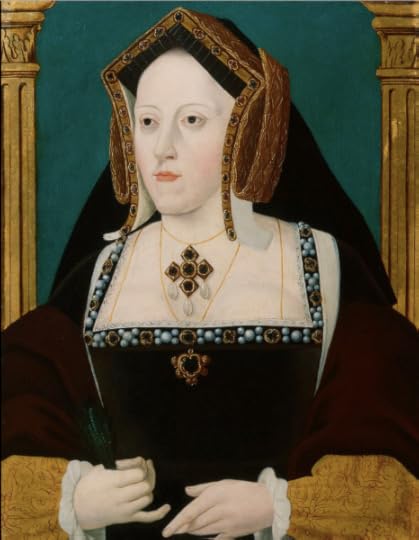 Katherine of Aragon
Katherine of Aragon This steadfastness of faith, demonstrated to Mary throughout the most turbulent years of her life, was the foundation of her reign. Just like her mother, Mary could not be shaken from what she believed to be God’s will. While Katherine is widely admired for her refusal to denounce her marriage or her faith, Mary is often vilified and her motives questioned. We must ask ourselves what Katherine would have done in Mary’s place. I believe she would have done precisely what her daughter did in an effort to see England’s bond with Rome restored. Both Katherine and Mary could be submissive and pious, believing deeply in the specific roles that God had assigned to them. However, they could each be bold and courageous when they believed God’s will was being thwarted.Queen Mary tried to make the most of her inheritance. She married late in life to a Spanish cousin, Prince Philip, and reinstated Catholic mass, but her lack of political acumen, failure to conceive an heir, and short reign caused her to leave a country in turmoil to her younger sister, Queen Elizabeth.
The Plantagenet Embers seriesBy Samantha Wilcoxson
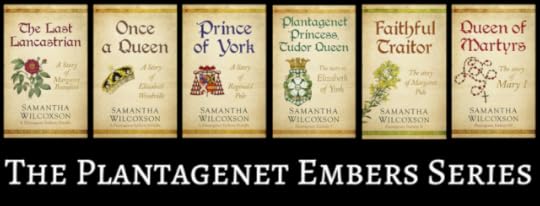
The Plantagenet Embers series explores the lives of the York remnant during the early Tudor era. Whether left in the background or maligned in the intervening centuries, the personal stories of these people help us appreciate their humanity and the difficult choices they were forced to make. Full length novels include the stories of Elizabeth of York, Margaret Pole, and Queen Mary I. The companion novellas take deeper looks at Margaret Beaufort, Elizabeth Woodville, and Reginald Pole. Learn aspects of the Tudors' story that you haven't heard before with these intimately told tales.
Amazon UK • Amazon US
Samantha Wilcoxson
 Writer of historical fiction and sufferer of wanderlust, Samantha enjoys exploring the lives of historical figures through both research and visiting historic places. Certain that no person is ever purely good or evil, she strives to reveal the deep emotions and motivations of those she writes about, enabling readers to connect with historical figures in a unique way. Samantha is an American writer with British roots and proud mother of three amazing teenagers. She can frequently be found lakeside with a book in one hand and glass of wine in the other.
Writer of historical fiction and sufferer of wanderlust, Samantha enjoys exploring the lives of historical figures through both research and visiting historic places. Certain that no person is ever purely good or evil, she strives to reveal the deep emotions and motivations of those she writes about, enabling readers to connect with historical figures in a unique way. Samantha is an American writer with British roots and proud mother of three amazing teenagers. She can frequently be found lakeside with a book in one hand and glass of wine in the other. Connect with Samantha: Blog • Facebook • Twitter • Amazon Author Page.
Published on June 03, 2019 00:00
June 2, 2019
#HistoricalFiction author, Chris Thorndycroft, is taking a look at the story of Drustan and Esyllt. Chris is also giving away 2 eBook copies of his upcoming #Arthurian novel — Sign of the White Foal @cthorndycroft
Drustan and Esyllt – The Lost Romance?By Chris Thorndycroft
 Tristan and Isolde, John Duncan, 1912
Tristan and Isolde, John Duncan, 1912Few romances of the middle ages resonate as much as the tragic tale of Tristan and Iseult. Preceding the illicit love affair of Lancelot and Guinevere of later Arthurian legend, there are many different versions of the Tristan and Iseult story but most conform to a basic outline.
Tristan of Lyonesse journeys to the court of his uncle King Mark of Cornwall. Impressed by the youth, Mark sends him to Ireland to fetch his bride-to-be; the princess Iseult. On the return voyage the pair inadvertently drink a potion and fall helplessly in love with each other. They continue their affair after Mark and Iseult’s wedding with tragic consequences involving King Arthur, lepers, burning at the stake and trial by red hot iron depending on which version you read.
There is no single source for this medieval precursor to Romeo and Juliet. The story was wildly popular from the 12thcentury onwards with different versions popping up everywhere from Scandinavia to Italy and it is difficult to know where the story came from or what its original form was.
Cornwall of the post-Roman period was part of Dumnonia; a kingdom that also covered Devon and bits of Somerset. Named after the pre-Roman Dumnonii tribe, it was eventually cut off from the other British kingdoms in the 6th century by the expansion of the West Saxons (who formed Wessex). The Saxons swallowed up swathes of Dumnonian territory leaving only the tip of the kingdom to the Britons. This area (variously known as Cerniu, Cernyw, or Kernow) may have been named after a sub-tribe called the Cornovii and came to be called Cornwall by the Anglo-Saxons (literally meaning ‘the Welsh of the horn’).
The characters of the Tristan and Iseult legend are unique among Arthurian characters in that there may be some archaeological evidence for them. Near Fowey in Cornwall there is a menhir (a tall standing stone) with a Latin inscription so worn by the elements that its translation has long been a matter of debate. (D)RVSTA/NVSHICIACIT | CVNO(M)ORIFILIVS ('Drustanus lies here, of Cunomorus the son') is the popular translation (1) although the D is backwards and may in fact be a C and an I which would make ‘Drustanus’ something like ‘Cirustanus’.
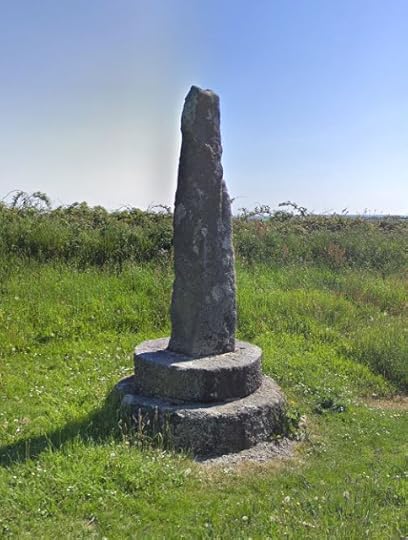 The 'Tristan Stone' near Fowey, Cornwall. Image capture: May 2018 © 2019 Google.
The 'Tristan Stone' near Fowey, Cornwall. Image capture: May 2018 © 2019 Google.Even if we accept that the name is Drustanus, it seems unlikely on the face of it, that this Drustanus has any relation to the Tristan of later romance. The name of Tristan’s father is usually given as Rivalen or Melias (probably based on Rhiwal and Meliavus – historical rulers of Brittany). However, the Life of St. Pol de Leon by the Bretton monk Wrmonoc refers to a king in southwest Britain called Marc ‘whom they call by another name, Quonomorius…’. If Cunomorus was King Marc then did his son, Drustanus become his nephew Tristan in later legend?
Cunomorus may be the same person as Conomor, a 6th century ruler of Brittany attested to in History of the Franksby Gregory of Tours and the lives of various saints such as Samson, and Tugdual. His name means ‘hound of the sea’ and by all accounts he was a nasty piece of work. As well as murdering several of his wives, he apparently earned his crown by murdering his predecessor and marrying his widow before forcing her and her son into exile. It is possible that a ruler like Conomor controlled territories on both sides of the English Channel. Brittany is so named for the large number of Britons who settled there in the post-Roman period (presumably fleeing the Anglo-Saxon expansions). Just as Dumnonia and Kernow made up the southwestern toe of Britain, there sprang up areas called Domnonea and Kernev (now Domnonée and Cornouaille) in Brittany, suggesting a transferral of tribal names to lands across the channel.
But there is a problem. The Marc of the Tristan and Isolde story also appears in some early Welsh sources but is referred to as ‘March son of Meirchion’ and there is no mention of a Cornish connection. In fact, the evidence seems to point to a northern source for the legend. The Welsh Triads (fragments of folklore grouped in threes) call him one of the three ‘fleet owners’ of the island of Britain while Tristan appears as ‘Trystan/Drystan son of Tallwch’ and Isolde as ‘Esyllt’.
One of the triads cryptically states …Drystan son of Tallwch, tending the swine of March son of Meirchyawn, while the swineherd went with a message to Essyllt. Arthur and March and Cai and Bedwyr were (there) all four, but they did not succeed in getting so much as one pigling - neither by force, nor by deception, nor by stealth…
More flesh is given to this Welsh version in the form of the Ystori Trystan; a fragment dating from the 16th century (likely copied from earlier sources). In this story Trystan ap Tallwch and Esyllt, the wife of March ap Meirchion, flee into the forest of Clyddon. March appeals to his cousin Arthur to mediate. Arthur suggests the following settlement; that one of them shall have Esyllt while the leaves are on the trees and the other while the leaves are not (i.e. summer and winter). March, thinking he is being clever, chooses winter for the nights are longer but Esyllt has the last laugh by pointing out that the holly, the ivy and the yew keep their leaves all year round and therefore she is Trystan’s for as long as he lives.
The forest of Clyddon will sound familiar to anybody who has tackled Nennius’s notoriously vague list of 12 battles attributed to Arthur in his Historia Brittonum. The 7th battle wasin the wood Celidon, which the Britons call Cat Coit Celidon. Could we have in the Ystoria Trystan a literary echo of the cause of one of Arthur’s battles? Clyddon/Celidon almost certainly refers to the Caledonian Forest which once covered vast parts of Scotland inhabited by the Picts. In lists of Pictish kings variations of ‘Drest’ and ‘Talorc’ appear frequently. There was even a ‘Drest mac Talorgan’ in the 8thcentury; a possible (if late) inspiration for Drystan son of Tallwch.
We find even more support for a northern source of the legend when we consider Tristan’s homeland of Lyonesse (Loenois/Leonois in earlier versions). This could refer to the Viscounty of Léon which bordered on the aforementioned Cornouaille in Brittany but ‘Loenois’ was also the Old French name for Lothian; a kingdom in northern Britain that bordered on the Pictish territories (2).
It’s very difficult to figure out where the story originated. While it is certainly possible that elements of the continental version made their way into Welsh folklore (particularly after the Norman conquest), it is also possible that the story originated in Britain and made its way to Brittany with refugees fleeing the Saxon advances. It is not inconceivable that a northern legend of Drustan and Esyllt was known across Britain and Bretons naturally placed a tale that they knew to be British in the part of Britain where their forefathers hailed from, namely Cornwall.
 The site of Tintagel Castle; the traditional location of the legend. But is it the original location...?
The site of Tintagel Castle; the traditional location of the legend. But is it the original location...?Sources
1. Thomas, A. C. (1994) And Shall These Mute Stones Speak? Post-Roman Inscriptions in Western Britain. Cardiff: University of Wales Press.2. Rachel Bromwich, editor and translator. Trioedd Ynys Prydein: The Welsh Triads. Cardiff: University of Wales Press, Fourth Edition, 20143. Translations of the Welsh Triads can be found at http://www.maryjones.us/ctexts/triads1.html 4. A Translation of the Ystori Trystan can be found at http://www.maryjones.us/ctexts/trystan.html
Drustan and Esyllt: Wolves of the Sea

An exiled prince,An unwilling bride,A love affair that tore a kingdom apart…
Defeated in battle by the warlord Arthur, Prince Drustan of the Picts is sent to the court of his uncle King March of Dumnonia as a political hostage. A cunning warrior, Drustan soon earns the trust of King March who sends him on a mission of vital importance.
When the Irish princess Esyllt learns of her betrothal to King March – a man she has never met – to seal an alliance between Britons and Gaels, she knows she is about to lose everything; her family, her home and her freedom. But when she meets the brash young Drustan who is to escort her to Dumnonia, she realises she has a chance of happiness and will stop at nothing to get it.
In a reckless romance that would become legend, Drustan and Esyllt plot to overthrow King March and rule Dumnonia for themselves. But in the chaos of 5th century Britain, things are never simple and both are ultimately forced to choose between love, ambition and family.
Drustan and Esyllt: Wolves of the sea is a spin-off novella of Chris Thorndycroft's upcoming Arthur of the Cymry trilogy. It is available for purchase from Amazonor you can pick up your free copy when you subscribe to ChrisThorndycroft's newsletter.
Excerpt
As the long grass whipped at Drustan’s bare legs and the sweat stood out on his naked back beneath the moonlight, he felt a freedom he had thought lost forever. Here he was, finally back in his element; a shadow within shadows, darting across bleak wilderness, the scent of war in his nostrils and a band of good fighters at his back.
The salty tang of the sea hung in the night air as the group of ten made their way towards the cliff edge. Drustan had sent the remaining twenty warriors to begin their assault on Din Tagel’s main gate. It was a diversion of course, much like the ongoing battle in the south was a diversion to keep March’s forces away from the peninsula fortress.
It had begun with Lord Branock assaulting the lands of his neighbour Colianus, stealing cattle, torching settlements and generally stirring up as much trouble as he could. It hadn’t taken long for March and his remaining allies to marshal their forces for battle and the Cornubians gladly met them between the rivers Fowydh and Camel. Drustan had sent Corbinal with them. He was a good fighter on horseback and besides, his stalwart companion was getting a bit long in the tooth for the type of assault he was planning.
Half of the warriors carried small coracles on their backs; simple constructions of sheep’s hide stretched over wicker frames. Drustan had instructed them in the making of them. It was the Picts’ preferred mode of transportation in the firths and rugged coasts of his homeland.
He led them to a point where the cliff dropped directly into the sea and no jagged rocks poked through the surf. It was a scheme born of madness or so Corbinal had put it. But, as Drustan had replied, in order to gain all, the true warrior risks all.
The coracle bearers tossed their light craft over the cliff’s edge and they floated down like spiders in the night to land on the surf, some right side up, some overturned but all bobbed about and were quickly drawn out by the foaming waves.
They looked to Drustan, this wild Pict who was their leader, stripped to his waist, hair bound back, body adorned with pagan scrawls in woad. He sucked as much air into his lungs as they could carry and then dove from the clifftop.
He fell like an arrow, straight and lethal, to slip into the waves with a barely noticeable splash. Their courage bolstered by the daring feat of their leader, the Cornubians followed suit, paddles gripped in their fists like spears. One by one they broke the surface, spluttering for the air that had been crushed from their lungs by the impact of the dive.
“To the boats!” cried Drustan some distance ahead of them. “Quickly before the current takes them!”
The current was already dragging the small vessels out to sea and the warriors made for them with all haste. As they reached them they scrambled in, two per boat, and immediately began fighting the current that threatened to drag them halfway to Erin.
Coming Soon….
Sign of the White Foal(Arthur of the Cymry trilogy Book 1)
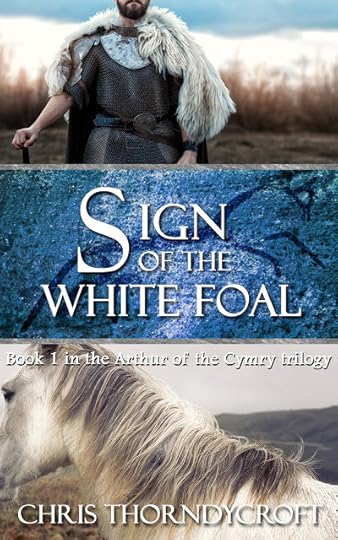
A generation after Hengest and Horsa carved out a kingdom in the east, a hero of the Britons rises in the west...
480 A.D. The sons of Cunedag have ruled Venedotia for fifty years but the chief of them – the Pendraig – is now dying. His sons Cadwallon and Owain must fight to retain their birthright from their envious cousins. As civil war consumes Venedotia, Arthur – a young warrior and bastard son of the Pendraig – is sent on a perilous quest that will determine the fate of the kingdom.
The Morgens; nine priestesses of the Mother Goddess have found the cauldron of rebirth – a symbol of otherworldly power – and have allied themselves with the enemy. Arthur and six companions are dispatched to the mysterious island of Ynys Mon to steal the cauldron and break the power of the Morgens. Along the way they run into the formidable Guenhuifar whose family have been stewards of Ynys Mon for generations. They need her help. The trouble is, Guenhuifar despises Arthur’s family and all they stand for…
Based on the earliest Arthurian legends, Sign of the White Foal is a rip-roaring adventure of Celtic myth and real history set in the ruins of post-Roman Britain.
Giveaway
Chris Thorndycroft is giving away two eBook copy of“Sign of the White Foal (Arthur of the Cymry trilogy Book 1)”

All you need to do answer this question:
Do you think the '(D)RVSTA/NVS' on the Tristan Stone in Cornwall really refers to the Tristan of legend or to somebody else?
• Leave your answer in the comments at the bottom of this post.
• Giveaway ends at 11:59pm BST on June 11th.
You must be 18 or older to enter.
• Giveaway is only open Internationally.
• Only one entry per household.
• All giveaway entrants agree to be honest and not cheat the system; any suspect fraud is decided upon by blog/site owner and the sponsor, and entrants may be disqualified at our discretion.
Pre-order your copy ofSign of the White Foal(Arthur of the Cymry trilogy Book 1)
Amazon UK • Amazon US
Chris Thorndycroft
 Chris Thorndycroft is a British writer living in Norway with his wife and two kids. He mostly writes historical fiction although got his start writing short horror stories for magazines and anthologies such as Dark Moon Digest and American Nightmare. Drustan and Esyllt is part of a decade long project to bring the story of 5th century Britain to life. This began with the
Hengest and Horsa
trilogy and continues with the upcoming Arthur of the Cymry trilogy. Chris also writes Retropulp, Steampunk and B-movie-inspired fiction under the pseudonym P. J. Thorndyke.
Chris Thorndycroft is a British writer living in Norway with his wife and two kids. He mostly writes historical fiction although got his start writing short horror stories for magazines and anthologies such as Dark Moon Digest and American Nightmare. Drustan and Esyllt is part of a decade long project to bring the story of 5th century Britain to life. This began with the
Hengest and Horsa
trilogy and continues with the upcoming Arthur of the Cymry trilogy. Chris also writes Retropulp, Steampunk and B-movie-inspired fiction under the pseudonym P. J. Thorndyke. Connect with Chris: Website • Newsletter• Twitter • Facebook • Goodreads.
Published on June 02, 2019 22:00
Check out D.K. Marley's fabulous new book — The Fire of Winter #NewRelease #HistoricalFiction #Macbeth @theRealDKMarley
The Fire of WinterBy D.K. Marley
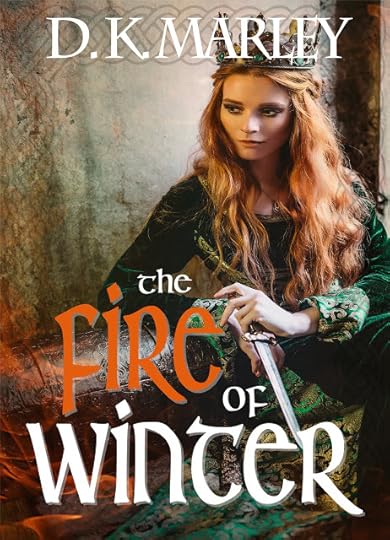
She is known as Lady Macbeth. What leads her down the path of murder? What secrets fire her destiny?
Gruah, the granddaughter of King Cìnéad III of the Royal Clan Alpin, marries two men in less than six months, one she loves and one she hates; one in secret, the other arranged by the High King of Scotland. At the age of eighteen, she lays her palm upon the ancient stone of Scone and sees her destiny as Queen of Scotland, and she vows to do whatever necessary to see her true love, Macbeth macFindlaech, beside her on the throne. Amid the fiery times and heated onslaughts from Denmark and England, as the rule of Scotland hangs in the balance, Gruah seeks to win the throne and bring revenge upon the monsters of her childhood, no matter the cost or amount of blood tainting her own hands; yet, an unexpected meeting with the King called the Confessor causes her to question her bloody path and doubt her once blazing pagan faith. Will she find redemption or has the blood of her past fire-branded her soul?
The story weaves the play by William Shakespeare with the actual history of Macbeth and his Queen in 11th-century Scotland. “...a woman's story at a winter's fire...” (Macbeth, Act III, Scene IV)
Praise for The Fire of Winter
“This beautifully written reworking of the Macbeth tale told from Lady Macbeth’s point-of-view flows from the page and you quickly become immersed in the politics and intrigues of feudal Scotland as she fights for her rightful place and her true love! A mesmerising read that grips from start to finish and Gruah is now one of my all-time favourite literary crushes.”
Iain Leonard, ARC Reviewer
“Brilliantly conceived and beautifully written, The Fire of Winter is a tale not to be missed by lovers of Shakespeare, lovers of history, or lovers of the written word.”
Riana Everly, Author of Teaching Eliza and Through a Different Lens
Pick up your copy ofThe Fire in WinterAmazon UK • Amazon US
DK Marley
 DK Marley is a historical fiction writer specializing in Shakespearean themes. Her grandmother, an English professor, gave her a volume of Shakespeare's plays when she was eleven, inspiring DK to delve further into the rich Elizabethan language. Eleven years ago she began the research leading to the publication of her first novel "Blood and Ink," an epic tale of lost dreams, spurned love, jealousy and deception in Tudor England. She lives in the United States with her husband and an English Lab named Max.
DK Marley is a historical fiction writer specializing in Shakespearean themes. Her grandmother, an English professor, gave her a volume of Shakespeare's plays when she was eleven, inspiring DK to delve further into the rich Elizabethan language. Eleven years ago she began the research leading to the publication of her first novel "Blood and Ink," an epic tale of lost dreams, spurned love, jealousy and deception in Tudor England. She lives in the United States with her husband and an English Lab named Max.Connect with DK Marley: Website • Facebook • Twitter • The Historical Fiction Club • BookBub • Goodreads.
Published on June 02, 2019 20:00
The Coffee Pot Book Club
The Coffee Pot Book Club (formally Myths, Legends, Books, and Coffee Pots) was founded in 2015. Our goal was to create a platform that would help Historical Fiction, Historical Romance and Historical
The Coffee Pot Book Club (formally Myths, Legends, Books, and Coffee Pots) was founded in 2015. Our goal was to create a platform that would help Historical Fiction, Historical Romance and Historical Fantasy authors promote their books and find that sometimes elusive audience. The Coffee Pot Book Club soon became the place for readers to meet new authors (both traditionally published and independently) and discover their fabulous books.
...more
...more
- Mary Anne Yarde's profile
- 159 followers



